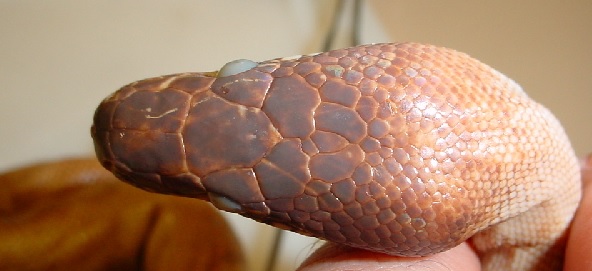Content  2 of 7
2 of 7 
Taxonomic history
The genus Leiopython Hubrecht, 1879
Only one year after the description as Liasis albertisii by Peters and Doria, 1878 and obviously having no knowledge about this description, the Dutch zoologist A.A.W. Hubrecht (1853-1915) examined another specimen from the Beccari collection from the Salawati Island, Indonesia. Based on the examination of this single specimen, Hubrecht introduced the specimen into a new monotypic genus, Leiopython as the new species Leiopyton gracilis. The genus was meant to be an intermediate between Liasis Gray, 1842 and Nardoa Gray, 1842 [the generic name Nardoa was preoccupied for a genus of starfish: Nardoa Gray 1840] but different from Nardoa, Leiopython has had pits in the upper labial scales and the rostral (Fig.1). Furthermore, the nostrils were laterally next to the nasal scales followed by diagonal pits. Hubrecht describes the new genus and the new species as follows:
Hubrecht states:"It differs from Nardoa in having pits not only on the inferior labials but on the rostal and upper labial plates as well, whereas it approaches this genus by the number and disposition of the shields on the head. [...] Nostrils lateral in the middle of the nasal plate, followed by a groove which extends backwards and downwards. Shields on the head extending beyond the eyes; no prefrontals; the number of frenals [=loreals] and preoculars considerably reduced; pits on the rostal, the upper and lower labials; scales short, smooth, rhombic." (Hubrecht, 1879:14-15)

Figure 2a/b: Leiopython gracilis, Holotype, lateral- und frontal view.
The species Leiopython gracilis Hubrecht, 1879
Hubrecht describes the new species as follows:
ōThe number of shields on the top of the head is reduced to eleven: two small internasals, two frontonasals about thrice as large as the foregoing, one frontal, two suboculars, two larger anterior and two smaller posterior parietals with a few smaller scales enclosed between the latter two pairs. The nasal plates are rather elongated; there is only one renal [=loreal] and one preocular on either side. Three or four postoculars. Rostal plate with two well marked pits; fourtheen upper labials, the two foremost of which are distinctly pitted; sixteen lower labials, the seven last but three of which are deeply pitted. [...] There are 284 ventral shields, 79 subcaudals divided into two along the median line and 49 to 51 longitudinal rows of scales. Scales short and smooth, more or less polygonal towards the tail. The colour (in spirit) of the back is rather light violet brown with a well marked iridescence, and a uniform yellowish white on the belly and chin. The top of the head is much darker than the back, although uniform as well. There is a very small white spot behind the eye; the upper and lower labials have their anterior half dark and their posterior half light coloured which gives a characteristic expression to the mouth.The only specimen in the Leyden Museum was found in Salawatti, as stated above; it measures 102.5 cm, of which the head occupies 3.5 cm, the tail 14 cm." (Hubrecht, 1879:15)

Figure 3: Leiopython gracilis, Holotype (RMNH 4796), dorsal view of the head.
Content  2 of 7
2 of 7 
